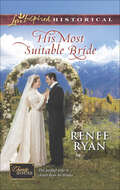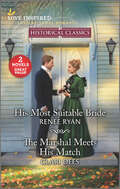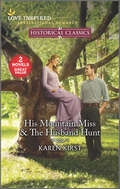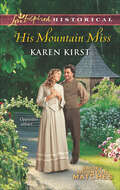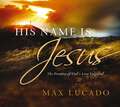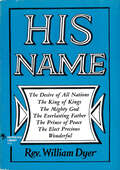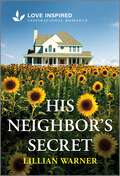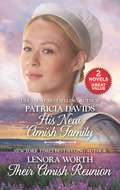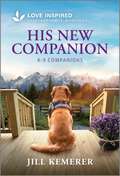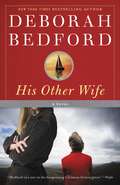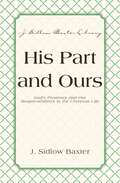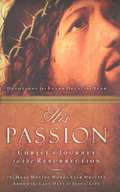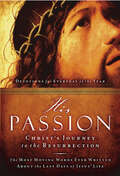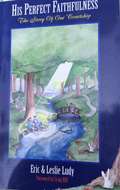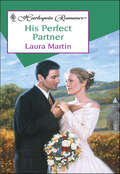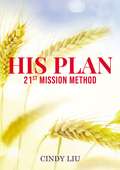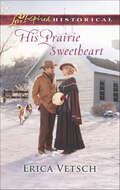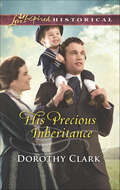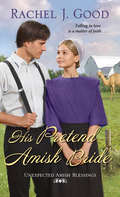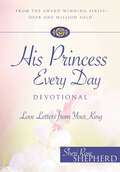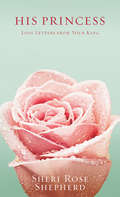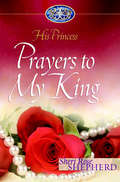- Table View
- List View
His Most Suitable Bride (Charity House #8)
by Renee RyanWhen her boss gives her the job of finding a handsome lawyer a wife, a woman falls for the bachelor herself in this inspirational historical romance.No one in Denver knows how close Callie Mitchell once came to ruin. Dowdy dresses and severe hairstyles hide evidence of the pretty, trusting girl she used to be. Now her matchmaking employer wants Callie to help find a wife for the one man who sees through her careful facade.For his business’s sake, Reese Bennett Jr. plans on making a sensible marriage. Preferably one without the unpredictable emotions that spring to life around Callie. Yet no matter how many candidates she presents to Reese, none compare with the vibrant, intelligent woman who is right under his nose—and quickly invading his heart.
His Most Suitable Bride and The Marshal Meets His Match
by Renee Ryan Clari DeesTwo women find their perfect love matches in this volume containing two complete inspirational historical romances set in the nineteenth-century American west.His Most Suitable Bride by Renee RyanNo one in Denver knows how close Callie Mitchell once came to ruin. Now her matchmaking employer wants Callie to help find a wife for the one man who sees through her careful façade—Reese Bennett Jr. Reese plans on making a sensible marriage. Yet no matter how many candidates she presents to him, none compare with the vibrant, intelligent woman right under his nose—and quickly winning his heartThe Marshal Meets His Match by Clari DeesMeri McIsaac is steadfastly single. Until the town’s new marshal, Wyatt Cameron, startles her and causes her to fall—literally—at his feet. Wyatt thinks Meri is stubborn and headstrong. Yet he recognizes her courage and loyalty, too, and the grief she carries. If he can protect her from a criminal desperate to cover his tracks, will Meri see that risking her heart could be the greatest adventure yet?
His Mountain Miss & The Husband Hunt
by Karen KirstFinding love in the Smoky MountainsHis Mountain MissNew Orleans aristocrat Lucian Beaumont wants only to sell his estranged grandfather’s property and escape the backwoods of Gatlinburg, Tennessee. But a stipulation in the will brings him head-to-head with local beauty Megan O’Malley. As Megan glimpses the man beneath the hardened veneer, she believes Lucian is here for a purpose: to heal his soul. And maybe, with Megan’s help, to heal his heart.The Husband Hunt Getting married is the only way for Sophie Tanner to protect her younger brother and keep her family’s Smoky Mountain farm. She’d like Nathan O’Malley to be the groom, but he can’t seem to get past their friendship…or their differences. Nathan always thought he’d fall in love with someone like himself—sensible and levelheaded. Sophie is his polar opposite. So why can’t he picture anyone else at his side?
His Mountain Miss (Smoky Mountain Matches)
by Karen KirstA Southern aristocrat meets his match in a feisty Smoky Mountain beauty in this sweet historical romance set in nineteenth-century Tennessee.Tennessee, 1881. New Orleans aristocrat Lucian Beaumont wants to sell his grandfather’s property and escape the backwoods of Gatlinburg. But a stipulation in the will brings him head-to-head with a local beauty. Megan O’Malley and the town must have access to the house. For the first time in his life the commanding Lucian finds himself at an impasse.Clearly the worldly gentleman doesn’t fit in Megan’s quaint Smoky Mountain town. But as she glimpses the man beneath the hardened veneer, she believes Lucian is here for a purpose. To heal his soul. And maybe, with Megan’s help, to heal his heart.
His Name is Jesus: The Promise of God's Love Fulfilled
by Max LucadoMax Lucado's first book that journeys from the birth of Christ to His resurrection.Drawing from his classic writing on Jesus combined with new reflections and breathtaking art, Max Lucado again opens our eyes--and hearts--to the life and work of the Savior in a way that will change lives forever. "Jesus was, at once, common and not; alternately normal and heroic. One minute blending in with the domino players in the park, the next commanding the hell out of madmen, disease out of the dying, and death out of the dead." Who was this man who spoke as easily with kids and fishermen as widows and waves? It is the question that has echoed down through the centuries to us today, and here is a visually stunning book that answers aspects of that question.
His Name: The Desire of All Nations - The King of Kings - The Mighty God - The Everlasting Father - The Prince of Peace - The Elect Precious - Wonderful (Colportage Library #265)
by William Dyer"Worldly excellencies ... cannot satisfy the sense of men, much less can it satisfy the souls of men." Reverend William Dyer knew full well that satisfication is found only when the soul is enamored with Christ, when the magnificent names of God are saturated with sweetness. Walk through seven names that describe the personhood of God, and find satisfaction as you draw yourself close to Him.
His Name: The Desire of All Nations - The King of Kings - The Mighty God - The Everlasting Father - The Prince of Peace - The Elect Precious - Wonderful (Colportage Library #265)
by William Dyer"Worldly excellencies ... cannot satisfy the sense of men, much less can it satisfy the souls of men." Reverend William Dyer knew full well that satisfication is found only when the soul is enamored with Christ, when the magnificent names of God are saturated with sweetness. Walk through seven names that describe the personhood of God, and find satisfaction as you draw yourself close to Him.
His Names Are Wonderful: Getting to Know God Through His Hebrew Names
by Elizabeth L. Vander Meulen & Barbara D. MaldaNames in the bible were chosen for a purpose. The names of God reveal his nature.
His Neighbor's Secret: An Uplifting Inspirational Romance
by Lillian WarnerWith a secret between them… Is there room for a second chance? When the new schoolteacher turns out to be the woman who once broke his heart, widower Jonah Raymond vows to keep his distance—until Kenzie Reid moves in next door. Now with his troubled foster son and Kenzie&’s daughter becoming friends, Jonah hopes they can put the past behind them. But winning Kenzie&’s trust is his first challenge…until he discovers her shocking secret.From Love Inspired: Uplifting stories of faith, forgiveness and hope.
His New Amish Family and Their Amish Reunion: A 2-in-1 Collection
by Lenora Worth Patricia DavidsSecond Chances at Love in Amish CountryHis New Amish Family by Patricia DavidsWidow Clara Fisher’s late uncle promised his farm to her—but she can’t find the documents to prove it! Desperate to stop her Englisch cousin from selling it, she seeks the help of auctioneer Paul Bowman. Paul has always been a wandering spirit, but will sweet, stubborn Clara and her children suddenly fill his empty life with family and love?Their Amish Reunion by Lenora WorthSingle mother Ava Jane Graber can’t believe her eyes. Her first love is back in Lancaster County. Years ago, Jeremiah did the unthinkable: left the Amish—and her—for the navy SEALs. Now the prodigal hero wants redemption from his community, his family and the woman he never forgot. For the ex-soldier, becoming Ava’s husband is his ultimate mission.
His New Amish Family: His New Amish Family The Soldier's Redemption His Two Little Blessings (The Amish Bachelors #6)
by Patricia DavidsUSA Today–Bestselling Author: In helping a brave woman save her home, a lonely man just may have found His New Amish Family.Her home—and heart—on the line . . . Widow Clara Fisher’s late uncle promised his farm to her—but she can’t find the documents to prove it! Desperate to stop her Englisch cousin from selling it, she seeks the help of auctioneer Paul Bowman.Paul’s always been a wandering spirit, but will sweet, stubborn Clara and her children suddenly fill his empty life with family and love?The Amish BachelorsAn Unexpected Amish RomanceAn Amish HarvestAn Amish NoelHis Amish TeacherTheir Pretend Amish CourtshipHis New Amish Family
His New Companion: An Uplifting Inspirational Romance (K-9 Companions)
by Jill KemererHealing from heartbreak Can start with a four-legged friend. Six years after losing his fiancée, rancher Ty Moulten still struggles with grief. Organizing a fundraiser in her honor and fostering a service dog feel like a step forward, and lead to meeting Ashlinn Burnier, the service dog training center&’s new administrative assistant. As Ashlinn helps Ty plan the fundraiser, he finds himself falling for Fritz, the tiny dachshund in his care, and for Ashlinn—who has a service dog of her own. But Ashlinn worries her health challenges make her a burden, and Ty wonders if he can open his heart again. Will two hardworking pups help them choose love over holding on to fear?From Love Inspired: Uplifting stories of faith, forgiveness and hope.K-9 Companions Book 1: Their Unbreakable Bond by Deb KastnerBook 2: Finding Her Way Back by Lisa CarterBook 3: The Veteran's Vow by Jill LynnBook 4: Her Easter Prayer by Lee Tobin McClainBook 5: Earning Her Trust by Brenda MintonBook 6: Guarding His Secret by Jill KemererBook 7: An Unlikely Alliance by Toni ShilohBook 9: A Reason to Stay by Deb KastnerBook 10: The Veteran's Holiday Home by Lee Tobin McClainBook 11: An Alaskan Christmas Promise by Belle CalhouneBook 12: A Steadfast Companion by Myra JohnsonBook 14: A Friend to Trust by Lee Tobin McClainBook 15: Her Alaskan Companion by Heidi McCahanBook 16: A Companion for Christmas by Lee Tobin McClainBook 17: Her Christmas Healing by Mindy ObenhausBook 18: Finding Their Way Back by Jenna MindelBook 19: Their Inseparable Bond by Jill WeatherholtBook 20: Bonding with the Babies by Deb KastnerBook 21: Her Son's Faithful Companion by Jill WeatherholtBook 22: Training the K-9 Companion by Jill KemererBook 23: A Companion for His Son by Lee Tobin McClainBook 24: Her Loyal Companion by Heidi MainBook 25: A K-9 Christmas Reunion by Lisa CarterBook 26: His Christmas Salvation by Lee Tobin McClainBook 27: Guarding Her Christmas Secret by Jill WeatherholtBook 28: A Faithful Guardian by Louise M. GougeBook 29: The Veteran's Valentine Helper by Lee Tobin McClainBook 30: Rescue on the Farm by Allie PleiterBook 31: An Unexpected Companion by Mindy ObenhausBook 32: Earning the Veteran's Trust by Lisa JordanBook 33: Holding Onto Secrets by Lee Tobin McClainBook 34: His New Companion by Jill KemererBook 35: The Soldier's K-9 Companion by Belle CalhouneBook 36: Her Surprise Neighbor by Lee Tobin McClainBook 37: Healing the Veteran by Ciara KnightBook 38: An Unexpected Christmas Helper by Lee Tobin McClain
His Other Wife: A Novel
by Deborah BedfordNew York Times bestselling author Deborah Bedford sweeps readers into this compelling drama with her trademark style of beautiful, lyrical writing. Since her divorce from Eric, Hilary has done everything she can to control life for herself and her son. Beneath a calm surface, she is terrified of failing Seth. She's worked hard to raise him on her own, and she's succeeded--he's now set to graduate from high school and enroll at the University of Illinois with a full scholarship.But Hilary's worst fears are realized when there is a rock-climbing accident at a post-graduation campout. A young girl is hurt, and Seth is arrested. Pamela, Eric's new wife and Seth's stepmother, blames Hilary for letting Scott go to the campout in the first place. With Seth's college scholarship now just a distant memory and his entire future at stake, the two women must come together for Seth's sake.Is Hilary's love strong enough to save her son and release him to her ex-husband's other wife?
His Part And Ours: God's Promises and Our Responsibilities in the Christian Life (J. Sidlow Baxter Library)
by J. Sidlow BaxterProbably Dr. Baxter’s most famous devotional work, His Part and Ours is truly a devotional classic. Profound truths are stated simply and graphically, imbedding them indelibly upon the mind and the heart of the reader. None of the devotional treasures unfolded by Dr. Baxter in this devotional giant can be lightly taken. God’s people need to be reminded anew that they are, of all creatures, most blessed - and that is just the function that this book will perform.
His Passion: Christ's Journey to the Resurrection
by Integrity PublishersAwaken to the Power of His Passion for You with Each New Day From Jesus' triumphal entry on Palm Sunday to the Last Supper's somber communion; from His agonizing evening in the Garden of Gethsemane to the trials before the officials; from His horrific crucifixion to the glorious events of Easter Sunday, Christ's final days shook the world. This book brings history--and His story--close, allowing your heart to bear witness to the power and meaning of His life, death and resurrection through 365 daily readings. Here are the most moving words ever written about the most important life of all--from Scripture itself and noted Christian authors of every age such as St. Augustine, Martin Luther, Jonathan Edwards, Thomas a Kempis, Oswald Chambers, A. W. Tozer, Max Lucado and others. Artistic renderings of Christ's journey to the Resurrection are included, making this a beautifully crafted, deeply meaningful book that will awaken you to what Jesus experienced in His passion for you.
His Passion: Christ's Journey to the Resurrection
by Thomas NelsonKeep the spirit of Holy Week alive all through the year with 365 daily devotions focused on the events of Palm Sunday to Easter Sunday.This 365-day devotional features the most moving words ever written about Jesus’ last days on earth—quotes from scripture followed by commentary by prominent voices of Christian history from biblical times to today. Enter deeply into the Passion of Jesus, and contemplate His entrance to Jerusalem, His clearing of the temple, and His washing of the disciples’ feet as well as His crucifixion, death, and resurrection.“Offers reflections from some of Christianity’s most recognizable and popular thinkers, from the classical (Origen, St. Augustine, John Bunyan, Thomas á Kempis, Charles Wesley) to the contemporary (Max Lucado, Philip Yancey, Ravi Zacharias, Walter Wangerin).” —Publishers Weekly
His Perfect Faithfulness: A Story of Our Courtship
by Eric LudyAlthough His Perfect Faithfulness is indeed the story of love and romance between a young man and his bride-to-be, it is even more the story of God's love and faithfulness toward anyone who will let Him be God. Many young people think that to allow God to manage their relationships with the opposite sex would be boring, restrictive, unfulfilling, and socially devastating. Eric and Leslie, through their lives and their writing, have masterfully demonstrated that God's purpose in all of our lives is not to restrict or hinder our romantic or sexual pleasure, but rather to maximize our enjoyment of and to take us to the very pinnacle of love, fulfillment, excitement, and pleasure.
His Perfect Partner
by Laura MartinSix years ago, Lean-Luc Manoire had walked out on Rachel Shaw without so much as a backward glance. She had never forgiven him. But now he was back and offering to help her out.She'd inherited a large, run-down house, and the only thing that could save it from ruin was a lot of money-and Jean-Luc certainly had that! With his financial aid and her business expertise they'd make the perfect team-just as long as the millionaire understood that being a sleeping partner did not give him access to her bed!
His Plan: 21st Mission Method
by Cindy LiuThe testimonies of a foul-mouthed truant's journey to a billionaire, an academic's "Sacrificial Succession" spiritual principles for mission, and a shy and broken-hearted women's joinery, proves the "Talent Giver," is eager to impart talent to enable those willing to serve His kingdom.Mission work has never been so accessible; the 21st Century Mission Method is a paradigm shift of the traditional ways of mission, to inspires Christians to do the "Great Commission." Using evangelists from the indigenous churches are the most effective and efficient way of mission in the modern age. It displays the manifold wisdom of God through His Church.God's call and plan for the church and Christian always align with the last words He spoke to His disciples: "Go make disciples of all nations, baptizing them in the name of the Father and of the Son and of the Holy Spirit (Matthew 28:19)."
His Prairie Sweetheart
by Erica VetschA Home for Her Heart After being jilted at the altar, Southern belle Savannah Cox seeks a fresh start out West and accepts a teaching position in Minnesota. But between her students' lack of English, the rough surroundings and sheriff Elias Parker's doubts and distrust, Savannah's unprepared for both the job and the climate. However, she's determined to prove she can handle anything her new town throws her way. Elias gives it a week-or less-before the pretty schoolteacher packs her dainty dresses and hightails it back home. But no matter how many mishaps he has to rescue her from, Savannah doesn't give up. Yet the real test is to come-a brutal blizzard that could finally drive her away, taking his heart with her...
His Precious Inheritance
by Dorothy ClarkThe Baby Surprise After an adorable toddler arrives on her boss's doorstep, Clarice Gordon's job offer transforms from full-time journalist to part-time nanny. Clarice agrees to care for Charles Thornberg's little brother as long as she can continue writing. But soon Charles stirs emotions in Clarice that are far from professional... Charles never dreamed he had a long-lost brother, but he'll do everything to ensure the little one is loved. And Clarice amazes him with the warmth and care she shows the boy-so different from the career women he's known. Charles doesn't like surprises in his neatly ordered life, though thanks to this one, he may have stumbled upon the family he's always wanted...
His Pretend Amish Bride: Unexpected Amish Blessings (Unexpected Amish Blessings #2)
by Rachel J. GoodIn a small Amish town like picturesque Lancaster, Pennsylvania, one solution to an indiscretion is to make a good marriage. Or perhaps, fake a respectable engagement . . . Priscilla Ebersol has a fulfilling life teaching special needs children—until her boyfriend&’s humiliating betrayal ruins her reputation and threatens her job. Ostracized for something she didn&’t do, Priscilla throws herself into a project on the benefits of camel&’s milk for autism. Her research leads her to a fledgling local camel farm, where she discovers far more than she bargained for . . . When a pushy Englisch company shows interest in shy, handsome Gabriel Kauffman&’s camel farm, he struggles to get out of a sticky negotiation. Lovely, well-spoken Priscilla appears at the perfect moment, and defends Gabe&’s business so well that she is mistaken for his wife. It&’s a ruse the two quietly continue, all the while secretly wishing it could be true. But though their bond deepens, Priscilla&’s heart is still wounded, and Gabe battles with a troubling secret. And when a misunderstanding comes between them, it will take faith, honesty, and trust in the future to overcome the past—and allow their partnership to blossom into something more . . . Visit us at www.kensingtonbooks.com
His Princess Every Day Devotional: Love Letters From Your King
by Sheri Rose ShepherdSee yourself as God sees you—as a daughter of the King. Toss aside your own insecurities and break out of the mold the media has created for you. You are a princess, and in these letters penned from God's perspective, you'll begin to discover just how dear you are to Him—and you were lovingly created to be in fellowship with Him. Walk your faith in confidence again as you find your rightful place as royalty.
His Princess: Love Letters from Your King (His Princess)
by Sheri Rose ShepherdThis beautiful four-color book opens the eyes of women to see themselves the way God sees them. Many don't even know that they are daughters of the King - chosen to be His Princess. Somewhere between childhood and adulthood, they trade in their fairy-tale dreams of being cherished for a tarnished identity fashioned by their own insecurities and the mixed-up messages of the media. Now, these tenderly adoring letters written from God's persepective demonstrate that every woman is beautiful just the way she is. Walking in confidence toward her God-given purpose, every woman can bless others - even future generations.From the Hardcover edition.
His Princess: Prayers to My King
by Sheri Rose ShepherdPrayers to My Kingis a beautiful gift book created to help women connect intimately with their God. Where the first book in the His Princesstrade; series reminded us that we are loved intimately and unconditionally by our King, this second book helps us express our deepest thoughts, desires, fears and failures by emulating King David in the Psalms and crying out to God through prayer. Christian women will gain a personal, dynamic prayer life. You want to feel God's presencehellip; embrace His promiseshellip; cry out to Himhellip; hellip;but don't know how! From your heart's deepest cry to life's joyful praises, nothing is off limits to Him. Go confidently now before His throne as you claim these powerful prayers as your own. He's waiting to hear from youhellip; If from there you will seek the Lord your God, you will find Him if you seek Him with all your heart and soul and life. Deuteronomy 4:29, amp Personal Growth/Christian Living/Women 1-59052-470-5 Multnomah Gifts ® Multnomah ® PublishersSisters, Oregon Story Behind the Book "Too many of God's "chosen ones" don't know how to have a real relationship with their Lord. We want to feel His presence, but we don't know how to let Him in. We want to see His promises come true, but we don't believe they are for us personally. We want to experience His power, but we keep trying to live life in our own strength. We want to cry out to Him, but we're afraid to break down and admit that we're weak. My prayer for this book is that women of God will have a personal, life-changing prayer life and be transformed into the daughters of the King they were destined to be from the beginning. "
